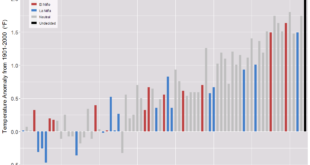The Yale Environment 360 article Redrawing the Map: How the World’s Climate Zones Are Shifting by Nicola Jones (10/23/18) provides animated maps, such as the one below, and quantitative statements about changing ecology including rates (great for a calculus class):
Lauren Parker and John Abatzoglou of the University of Idaho tracked what would happen to hardiness zones from 2041 to 2070 under future global warming scenarios, and found the lines will continue to march northward at a “climate velocity” of 13.3 miles per decade.
One study in northern Canada found that the permafrost around James Bay had retreated 80 miles north over 50 years. Studies of ground temperatures in boreholes have also revealed frightening rates of change, says Schafer. “What we’re seeing is 20 meters down, it’s increasing as high as 1-2 degrees C per decade,” he says. “In the permafrost world that’s a really rapid change. Extremely rapid.”
North America is seeing the opposite phenomenon: Its arable land is romping northward, expanding the wheat belt into higher and higher latitudes. Scientists project it could go from about 55 degrees north today to as much as 65 degrees North — the latitude of Fairbanks, Alaska — by 2050. That’s about 160 miles per decade.
The article includes potential ramifications of these changes along with other quantitative information.
Graphic: Hardiness zones in the U.S., which track average low temperatures in winter, have all shifted northward by half a zone warmer since 1990. SOURCE: UNITED STATES DEPARTMENT OF AGRICULTURE. GRAPHIC BY KATIE PEEK.
